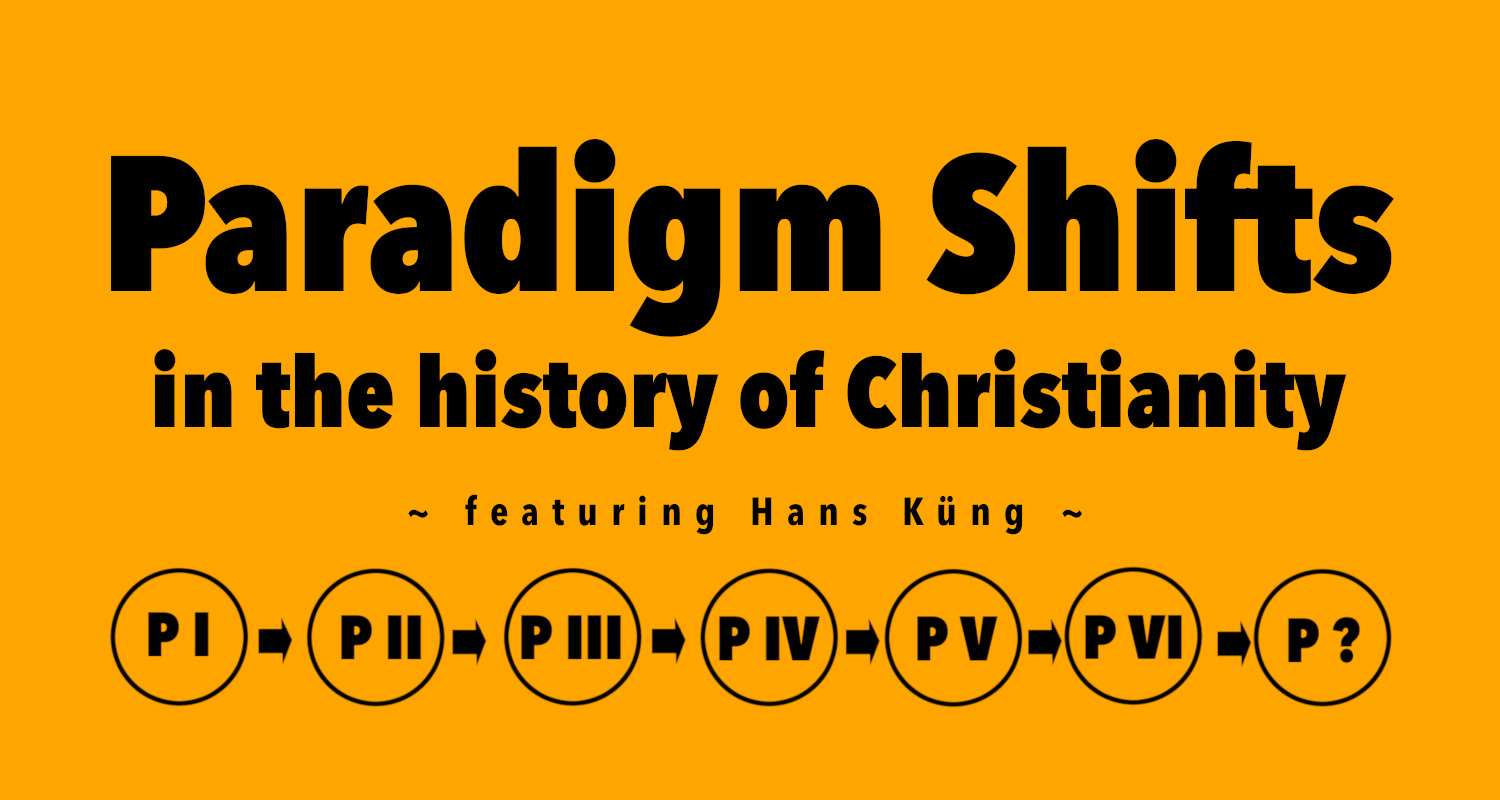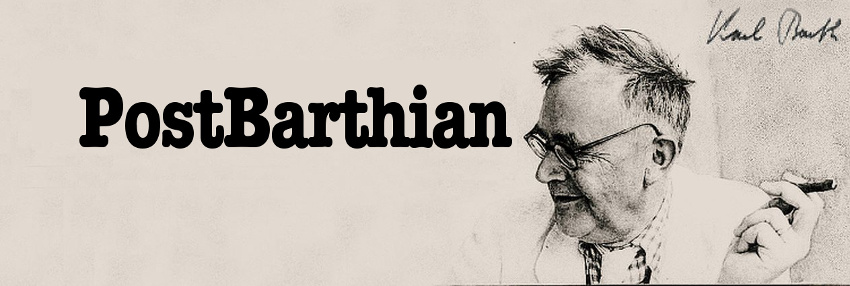 In his book Christianity: Essence, History and Future, Hans Küng divides the history of Christianity into six paradigm shifts that he identifies as "the Jewish Christian apocalyptic, Hellenistic Byzantine, Roman Catholic, Reformation Protestantism and Enlightenment modern paradigms" [1] as well as a current "Contemporary ecumenical paradigm" [2]. Küng's six paradigm shifts correspond to Thomas Kuhn's The Structure of Scientific Revolutions, defines a shifting paradigm as "an entire constellation of beliefs, values, techniques which are shared by the members of a particular community." So each of Küng's six paradigm shifts correspond epoch making changes in the "macromodel of society, religion, [and] theology" throughout Christianity [3] that are comparable to the Copernican revolution (which is a paradigm shift par excellence).
In his book Christianity: Essence, History and Future, Hans Küng divides the history of Christianity into six paradigm shifts that he identifies as "the Jewish Christian apocalyptic, Hellenistic Byzantine, Roman Catholic, Reformation Protestantism and Enlightenment modern paradigms" [1] as well as a current "Contemporary ecumenical paradigm" [2]. Küng's six paradigm shifts correspond to Thomas Kuhn's The Structure of Scientific Revolutions, defines a shifting paradigm as "an entire constellation of beliefs, values, techniques which are shared by the members of a particular community." So each of Küng's six paradigm shifts correspond epoch making changes in the "macromodel of society, religion, [and] theology" throughout Christianity [3] that are comparable to the Copernican revolution (which is a paradigm shift par excellence).
The strength of Küng's historical analysis (which he also uses in his book Judaism and Islam), is the ecumanical import it brings to each of the paradigms because each paradigm shift represents a new development in Christianity that cannot be undone and that should be appreciated for its unique contribution to Christianity. The consequent is that a renewed appreciate for each development, a greater understand why the paradigm shifts occurred, and it also explains counter movements that resisted the paradigm shifts today. For instance, Protestant Fundamentalism is explained as a Protestant Reformation paradigm (P IV) rejection of the Enlightenment modern paradigm (P V).
Hans Küng divides church history into the following six epochs [4]:
Paradigm Description P/I Early Christian apocalyptic paradigm P/II Early church Hellenistic paradigm P/III Medieval Roman Catholic paradigm P/IV Reformation Protestant paradigm P/V Enlightenment modern paradigm P/VI Contemporary ecumenical paradigm (postmodern)?
P I: Early Jewish Christianity
The early Jewish Christianity paradigm (P I) is the earliest stratum of Christianity that preceded and birthed the New Testament. Although the Orthodox Church (P II) often thinks of itself as the preservation of the earliest Church tradition, this is not true. The earliest tradition was an Aramaic Jewish church that was relatively free from Hellenization, and it wasn't until after Christianity spread throughout the Roman empire that it assumed a Hellenized form. It is remarkable that the entire New Testament is written in Greek. Küng argues that Islam is a preservation of this early Jewish Christian paradigm (P I) and Islam represent a lost early Jewish Christian rejection of the Hellenistic Christian paradigm (P II) that followed it. Küng identifies James and the Jerusalem delegates (in conflict with Paul) as representatives of this early Christianity.
P II: Early church Hellenistic paradigm
The early Church Hellenistic paradigm (P II) corresponds to the Greek Orthodoxy and the Byzantine empire. Christianity quickly became Hellenized and desemitized as its center moved from Jerusalem to Rome. It is surprising how quickly Christianity had vacated the land of its birth (similar to Buddhism leaving India). The first early Jewish Christianity paradigm (P I) has essentially perished, and Greek Christianity (P II) has assumed its place as the early church paradigm. This second paradigm introduced the ecclesial hierarchy to the church under the rule of bishops and ultimately the emperor. It also subjugated Christian theology to Greek philosophy, most notably in its concicular definitions of the Trinity and Christology. Küng names Origen, Athanasius and the Cappadocians as the principle characters from this epoch.
P/III: Medieval Roman Catholic paradigm
The Roman Catholic paradigm (P III) emerged as the third paradigm shift, and this corresponds to the latinization of Christianity, and the translation of all Christian vernacular from Greek to Latin. In this paradigm, the bishop of Rome assumed primacy over all the other bishops as well as over the emperor that culminated with Pope Innocent III who was a global dictator. It also emerged as the dominant form of Christianity throughout the middle ages. Above all, Augustine of Hippo is the defining figure of this epoch, but Küng also names Thomas Aquinas and others as well.
P/IV: Reformation Protestant paradigm
Küng describes the Protestant Reformation (P IV) as a paradigm par excellence because of the rapidity in which Christianity changed in response to Martin Luther, John Calvin, Erasmus and the other reformers, and this paradigm shift most closely aligns with Thomas Kuhn's description of the Copernican revolution as the ideal paradigm shift (ironically because both Luther and Calvin condemn the Copernican model). The Reformation overthrew the Medieval rule of the Roman Catholic Popes (P III) and led to the rise of the modern nation states. It introduced a plurality of churches that were not subdued by the rule of either the emperor (as in early Greek Christianity P II) or the pope (as in Latin Romanized Christianity P III) but instead to a commitment to the bible that was codified into confessions, especially the Augsburg Confession and the many Reformed confessions.
P/V: Enlightenment modern paradigm
The Enlightenment modern paradigm (P V) was the rise of reason that corresponded to rise of technology and other sciences. In the Church, the great Friedrich Schleiermacher is the name most [m]aligned with this epoch. The enlightenment modern paradigm overthrew the rule of the Church confessions and local rule, and lead to the development of human rights and nation states ruled by democracy (instead of the tyrannical kings or popes).
P/VI: Contemporary ecumenical paradigm (postmodern)?
Küng ends the book with an analysis of our current postmodern paradigm (P VI) that reconcises reason has criticized itself and it does not have supremacy over faith. The postmodern paradigm is our time of ecumanical dialogue, where in the Church is discovering a new self-understanding of the different Church paradigms that exist, and Christianity's relationship to its kin: Judaism, Islam. Also Christianity is understanding its ecumene with the other religions, and humanity (especially women's rights) and also with the earth (as in environmentalism).
Sources:
1. Hans Küng. Christianity: Essence, History, Future. Continuum, 1996. p. 792
2. Küng. Ibid. [Inner cover diagram]
3. Küng. Ibid. [Inner cover diagram]
4. Küng. Ibid. [Inner cover diagram]
Related: Christianity: Essence History Future, Hans Küng, paradigm shifts, The Structure of Scientific Revolutions, Thomas Kuhn



July 13th, 2019 - 18:54
These observations are cross-referenced with the post about the ‘repression of early Jewish Christianity’.
Well, I haven’t read much of Kung, except, ‘On Being a Christian.’ And that was 30 – 35 years ago. I can see a trajectory from what he said then and there to what you have said in this post [and the one about the repression of earliest Jewish Christianity] about Kung [e.g., regarding world religions and Islam]. A friend of mine who is a chemist has very much recommended Kuhn. But I have already read most of Karl Popper’s English translated books as well as Michael Polanyi’s ‘Personal Knowledge: Towards a Post-Critical Philosophy.’ I am interested in philosophy of science a little, so this adaptation of Kuhn by Kung could be interesting if I could be motivated. While I find I might probably agree over all with much of Kung’s overall outline as you have presented it, there are some problems which might sink his endeavor as it relates to any effort to rescue something to fortify spiritual belief.
First and foremost, if his presumption regarding earliest Jewish Christianity is indeed what is the case, then by definition any actual hisorical reconstruction is going to be sheer fantasy guesswork! This was shown by Schweitzer regarding the 19th century questers and by James M. Robinson about the New Questers in the 20th. The Jesus Seminar has put the last nail in the coffin now in the 21st century. We then are in a position where the historical critical fact is that the PII Hellenistic christology is based on sheer Greco-Roman syncretism. And then there is the fact that PI earliest Jewish Christian stratum is beyond any possibility of recovery. I doubt, based on this model, that the historical Jesus [if he even really existed] was anything like what Kung, Barth, Bonhoeffer, or Cullmann would like to pretend Jesus was [viz., trinitarian or even arian nonsense]. The PI layer is simply our own fantasy reconstructive delusions about what might have been in the primitive community’s delusional fantasies.
That leads to the third issue regarding whether as to whether it is even possible to recover what I call some form of proto-Islamic nonsense WHICH KUNG suspects?. The answer is, NO!
July 14th, 2019 - 23:08
I really appreciated your comment, and I’ve been on that same journey myself. And I understand your strong NO! at the end, but that Barthian in me always finds a hidden YES! inside every NO! You are right that we may not reconstruct P I, and I read the same books as you and agree with them. However, I side with Kung and believe that there is a core and abiding truth in P I that was carried forward in not only P II but all the following paradigms, even if it is not possible to reconstruct P I (pace schweitzer). Kung is not arguing that Islam is a preservation of P I, but that Islam may not be rejected because it is an heir of P I, and therefore all islamophobia must be rejected and we must see Islam as a sibling on par with Judaism.
What do you think?
Grace and peace,
Wyatt
July 15th, 2019 - 10:53
You said, “You are right that we may not reconstruct P I, and … I side with Kung and believe that there is a core and abiding truth in P I that was carried forward in not only P II but all the following paradigms, even if it is not possible to reconstruct P I (pace schweitzer).”
An old religious studies professor of mine during college days once wrote something ,somewhere, like: “If anyone thinks that he can know or follow the religion of Jesus or Paul, he is sadly deluded.” If that is so, then it would definitely put a damper on things.
July 15th, 2019 - 08:14
I think that Kung was further extending some of his earlier thoughts which he made around p. 90f in OBAC when discussing ‘Anonymous Christianity.’ He is like a magnificent theological Don Quixote. This is true especially around pp 156 &f in OBAC where he discusses such beckoning ideas such as ‘history and faith’s certainty”… Magnificent, but… how sad though. Doesn’t change anything, though. I might need to re-peruse this thing [OBAC]. And despite seeing value in Hume’s assessment regarding the final usefulness of any volumes of divinity, I still have in Barth’s CD I:1; III:3; IV:1. Also Brunner’s D1, D2, RR, Imperative, Mediator.
Now, on the serious side I totally agree with “all islamophobia must be rejected”!
On the humorous side: what might happen if you were to stand up in a public square in the Middle East, Malaysia, Arabian Basin area, and announce, “…we must see Islam as a sibling on par with Judaism!” What would be your chances? 🙂